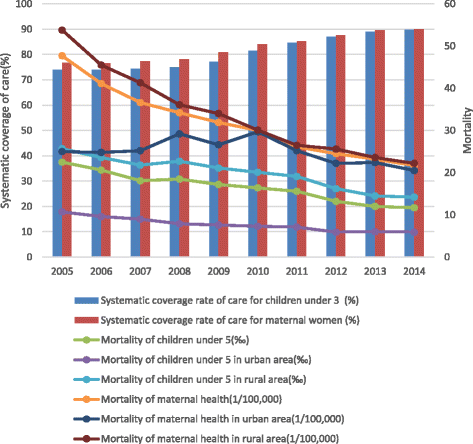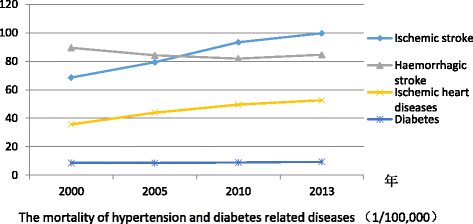Financing strategies to improve essential public health equalization and its effects in China
- PMID: 27905941
- PMCID: PMC5134004
- DOI: 10.1186/s12939-016-0482-x
Financing strategies to improve essential public health equalization and its effects in China
Abstract
Background: In 2009, China launched a health reform to promote the equalization of national essential public health services package (NEPHSP). The present study aimed to describe the financing strategies and mechanisms to improve access to public health for all, identify the strengths and weaknesses of the different approaches, and showed evidence on equity improvement among different regions.
Methods: We reviewed the relevant literatures and identified 208 articles after screening and quality assessment and conducted six key informants' interviews. Secondary data on national and local government health expenditures, NEPHSP coverage and health indicators in 2003-2014 were collected, descriptive and equity analyses were used.
Results: Before 2009, the government subsidy to primary care institutions (PCIs) were mainly used for basic construction and a small part of personnel expenses. Since 2009, the new funds for NEPHSP have significantly expanded service coverage and population coverage. These funds have been allocated by central, provincial, municipal and county governments at different proportions in China's tax distribution system. Due to the fiscal transfer payment, the Central Government allocated more subsides to less-developed western regions and all the funds were managed in a specific account. Several types of payment methods have been adopted including capitation, pay for performance (P4P), pay for service items, global budget and public health voucher, to address issues from both the supply and demand sides. The equalization of NEPHSP did well through the establishment of health records, systematic care of children and maternal women, etc. Our data showed that the gap between the eastern, central and western regions narrowed. However the coverage for migrants was still low and performance was needed improving in effectiveness of managing patients with chronic diseases.
Conclusions: The delivery of essential public health services was highly influenced by public fiscal policy, and the implementation of health reform since 2009 has led the public health development towards the right direction. However China still needs to increase the fiscal investments to expand service coverage as well as promote the quality of public health services and equality among regions. Independent scientific monitoring and evaluation are also needed.
Keywords: China; Effects; Equalization; Financing strategies; Public health services.
Figures





Similar articles
-
Inter-provincial inequality of public health services in China: the perspective of local officials' behavior.Int J Equity Health. 2018 Jul 31;17(1):108. doi: 10.1186/s12939-018-0827-8. Int J Equity Health. 2018. PMID: 30064429 Free PMC article.
-
Engaging sub-national governments in addressing health equities: challenges and opportunities in China's health system reform.Health Policy Plan. 2013 Dec;28(8):809-24. doi: 10.1093/heapol/czs120. Epub 2012 Dec 4. Health Policy Plan. 2013. PMID: 23221008
-
Anatomy of intergovernmental finance for essential public health services in China.BMC Public Health. 2022 May 9;22(1):914. doi: 10.1186/s12889-022-13300-y. BMC Public Health. 2022. PMID: 35534861 Free PMC article.
-
Experiences and Challenges of Implementing Universal Health Coverage With China's National Basic Public Health Service Program: Literature Review, Regression Analysis, and Insider Interviews.JMIR Public Health Surveill. 2022 Jul 22;8(7):e31289. doi: 10.2196/31289. JMIR Public Health Surveill. 2022. PMID: 35867386 Free PMC article. Review.
-
Payment methods for healthcare providers working in outpatient healthcare settings.Cochrane Database Syst Rev. 2021 Jan 20;1(1):CD011865. doi: 10.1002/14651858.CD011865.pub2. Cochrane Database Syst Rev. 2021. PMID: 33469932 Free PMC article.
Cited by
-
Unintended effects of Janani Suraksha Yojana on maternal care in India.SSM Popul Health. 2020 Jun 25;11:100619. doi: 10.1016/j.ssmph.2020.100619. eCollection 2020 Aug. SSM Popul Health. 2020. PMID: 32642548 Free PMC article.
-
Efficiency trends of essential public health services and possible influencing factors since the new round health reform in China: a case study from Hainan Province.Front Public Health. 2023 Nov 6;11:1269473. doi: 10.3389/fpubh.2023.1269473. eCollection 2023. Front Public Health. 2023. PMID: 38026396 Free PMC article.
-
Changes in inequality in utilization of preventive care services: evidence on China's 2009 and 2015 health system reform.Int J Equity Health. 2019 Nov 11;18(1):172. doi: 10.1186/s12939-019-1078-z. Int J Equity Health. 2019. PMID: 31711485 Free PMC article.
-
The Relationship Between Homeownership and the Utilization of Local Public Health Services Among Rural Migrants in China: A Nationwide Cross-Sectional Study.Front Public Health. 2020 Dec 7;8:589038. doi: 10.3389/fpubh.2020.589038. eCollection 2020. Front Public Health. 2020. PMID: 33365296 Free PMC article.
-
Can public health services promote the settlement intention of migrant workers: empirical analysis from China.Front Public Health. 2024 Nov 20;12:1472223. doi: 10.3389/fpubh.2024.1472223. eCollection 2024. Front Public Health. 2024. PMID: 39635217 Free PMC article.
References
-
- State Council of the People’s Republic of China. Regulation on the practicing of village doctors. Beijing: SCPRC; 2004. Available from: http://www.gov.cn/banshi/2005-08/02/content_19251.htm Accessed 25 June 2016.
-
- Balabanova D, McKee M, Mills A. ‘Good health at low cost’ 25 years on: What makes a successful health system? London: LSHTM; 2011. - PubMed
MeSH terms
LinkOut - more resources
Full Text Sources
Other Literature Sources
Medical
Miscellaneous

